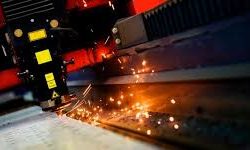The basics of sheet metal fabrication
In the most basic of terms, sheet metal fabrication is the construction of buildings, compliance’s, vehicles, engine parts and a wide range of other items from by forming, shaping and joining metal together. The metals are often used alongside other materials such as plastics and concrete, but the basics of sheet metal fabrication has never changed.
When metal is produced from ores and other materials, it is often formed into flat sheets. The sheets come in varying thicknesses from the thickest which is known as plate, to the thinnest which we generally recognise as foils. These sheets can be made from various metals, with steel and aluminium being among the most common.
The basics of Sheet metal fabrication generally consists of three key processes; cutting, bending and assembling.
Cutting
Cutting is the process of taking the raw material in the form of sheet metal and cutting it into the basic shape that will then be folded to create a three-dimensional structure in the next stage. There are a number of different ways to cut sheet metal, however the best results are obtained by hydraulic punches and laser cutting, which are both quick and precise.
Bending
Once the shape has been cut out of the sheet metal, it can be manipulated to create the intended form, such as an enclosure. This process requires specialist machines and expert knowledge to accomplish successfully but is not unsimilar to that of manipulating cardboard to create a box. Bending of the sheet metal can be done manually with hammers or by machine depending on the outcome that is required.
For thicker sheets, press brakes apply extreme pressure to the sheets to bend them into shape as needed. Modern sheet metal fabrication factories use CNC Folding machinery that makes sheet metal fabrication far easier and faster, helping with mass production.
Assembling
Steel fabricators will often create separate pieces that then need to be joined together to help make the final product. Manufacturers may use a single technique or a variety of techniques depending on various requirements such as stress levels, water tightness, etc.
One common form of joining sheet metal together is with rivets and these rivets can often be seen on various objects, particularly in larger objects that use thick sheets. Welding is another popular method, along with crimping (where the metal is held together by further bending) and other techniques such as the use of adhesives and fasteners are also quite common.
Due to the nature of sheet metal, it tends to be very robust and strong, which means it can be used for various means and is popular across many different sectors and industries. At Yorkshire Laser and Fabrication we do not focus our business operations on one particular industry, instead we specialise in how sheet metal fabrication can best serve your particular industry. To this end, we are experts in the field of sheet metal fabrication and have a vast understanding of its applications within a variety of different fields.

